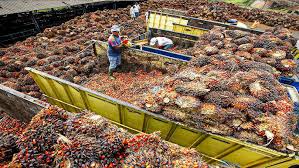An oil palm begins to produce 3 or 4 years after it has been planted. If proper care is not taken of the seeds, they will germinate only after several years meanwhile At the research stations, the seeds are kept in a room where it is always very hot, This makes the seeds germinate sooner, after 90 to 100 days. Each seed germinated is planted in a small plastic container.
A new leaf grows every month, the young seedling stays in the container for 4 to 5 months. When you see a left with two points (bifid leaf) coming up, transplant the seedling out into the nursery.
The seedling stays in the nursery for 1 year and when it has about 15 green leaves, it is planted in the palm grove. The seedling is therefore 16 to 18 months old when it is ready to be planted in the palm grove.
When the young oil palm has been planted in the palm grove, it produces male flowers and the flowers form at the base of each leaf. For several months, the oil palm produces only male flowers. After that, for several months, it produces only female flowers.
The male flowers are grouped in spikes, the female flowers form other spikes, the male flowers fertilize the female flowers. Fertilized female flowers turn into a cluster of fruit.
The oil palm has no branches it only has a trunk and leaves. The trunk, sometimes called a “stipe” is the stem of the oil palm tree. At the tip of the stem there is one bud – one only: This is the growing point, which makes the oil palm live and grow.
Read Also: Regions where Oil Palms should be Cultivated for Maximum Profit
Note: If the growing point dies, the tree dies as well; therefore care must be taken to prevent that from happening.
The growing point of the adult produces about 20 to 25 leaves every year. It is most important that the growing point should produce many leaves, because there will be a flower at the base of each leaf. If there are many leaves, there will be many flowers. And if there are many flowers, there will be many clusters of fruit.
The oil palm grows well and produces a lot in regions where it is very hot, where the sun is very strong, and where it rains a great deal.
The fruits of the oil palm yield oil and The clusters consist of spikelets, The spikelets contain the fruit and before getting the oil out of the fruit, the fruit must be separated from the spikelets.
The fruits of the oil palm consist of the following parts:
Pulp: the pulp is yellow; when the pulp is crushed it yields palm oil.
Seed: inside the shell of the seed is the kernel; when the kernel is crushed, it yields palm kernel oil. The kernel also contains the germ.
The fruits of all oil palms are not the same.
- They are not all of the same size.
- The pulp is not equally thick in all of them.
- The shell is not equally thick.
- Some kernels have no shell at all.
There are different varieties of oil palm:
- Dura palms have kernels with a thick shell;
- Pisifera palms have kernels with no shell;
- Tenera palms have kernels with a thin shell.
When oil palms bear many and large fruit clusters, they yield a lot of oil. But to get a lot of oil, each fruit must also contain a lot of pulp, a shell that is not very thick, and a big kernel.
Related: The Concept of Animal Production on Agriculture
Researchers have developed varieties of oil palm which produce many large clusters with fruits that have a lot of pulp, a thin shell and a big kernel.
The selected oil palms varieties include: In order to get a lot of oil, the female flowers of a Dura palm are fertilized with the pollen from a Pisifera palm. Once they are fertilized, the female flowers turn into fruits. These fruits are of the Tenera variety. The fruits of the Tenera palm have a lot of pulp, a thin shell and a big kernel.
Read Also: Reasons why you should Invest in Oil Palm Business

